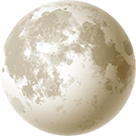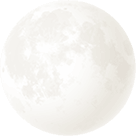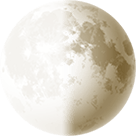May Night Sky Astronomy (2023)What to see in May's night sky including Moon phases, a penumbral lunar eclipse, planet guide, and the Eta Aquarid meteor shower.
May Moon Phases
Many cultures refer to May's full moon as the flower moon thanks to the abundant blooming that occurs as spring gets going properly. Other names include the hare moon, the corn planting moon, and the milk moon.
Full Moon and New Moon for May 2023

May 2023 Full MoonSat 6th May

May 2023 Last QuarterSat 13th May

May 2023 New MoonSat 20th May

May 2023 First QuarterSun 28th May
Penumbral Lunar Eclipse
There will be a Penumbral Lunar Eclipse on May 5th which will be visible in Europe, Africa, Asia, and Australia with totality occurring at 17:22 UT. Penumbral eclipses only slightly dim the Moon's light and many casual observers might not notice a difference at all. NASA Map and Eclipse Information .
May Planets
Mercury is at its second elongation of the year and will be 25 degrees from the Sun, however, it remains a difficult target since it will only be magnitude 0.6. Jupiter will be bright around 10 degrees to the upper right which may help in locating Mercury in the morning sky.
Venus is always brilliant, shining with a steady, silvery light. Mornings in the eastern sky at dawn from early January through to mid-June. This month Venus is still close to M35 appearing the in the same binocular field of view. On the 22/23rd of May, the Moon is close by.
Mars is visible in the night sky from January to mid-July, then shifts to the morning sky from mid-Oct to the end of December. Towards the end of the month Mars will be close to M44.
Jupiter was in conjunction with the Sun last month and slowly begins to reappear in Early May in the predawn twilight. On the 17th the waning crescent moon will be a degree to the right of Jupiter and the best views will be around 45 minutes before sunrise. There is a rare afternoon occultation by the moon on 17th May which will be visible in the UK. Start observing from 14:20 BST (13:20 UT).
Saturn is visible in the mornings from late January to early July, and then in the evenings from July to December. It is not well positioned in May.
May Meteor Showers
The Eta Aquarids is an above-average shower, capable of producing up to 60 meteors per hour at its peak. Most of the activity is seen in the Southern Hemisphere. In the Northern Hemisphere, the rate can reach about 30 meteors per hour. It is produced by dust particles left behind by comet Halley, which has been observed since ancient times. The shower runs annually from April 19 to May 28. It peaks this year on the night of May 6 and the morning of May 7. The nearly full moon this year will be a problem. Meteors will radiate from the constellation Aquarius, but can appear anywhere in the sky.

May Deep Space Objects
The spring night skies are home to some wonderful globular clusters. M3 in Canes Venatici and M5 in Serpens are good targets for a small telescope and can also be glimpsed with binoculars from sites with dark skies.
As Hercules rises, globular clusters M13 and M92 become visible targets. M13 is one of the brightest and best-known globular clusters in the northern sky. The Hercules Globular Cluster was the target of the Arecibo message, a message beamed from the Arecibo Observatory in Puerto Rico in 1974, which contained information about the human race, Earth's location and other data. However, the message will never reach its target. It will arrive at the past position of M13 in about 25,000 years, but the cluster will no longer be there at that point.

Surfboard Galaxy (M108) is a barred spiral galaxy in Ursa Major. Even though it appears almost edge-on, M108 is a popular target among amateur astronomers and astrophotographers because details of its structure can be seen even in amateur telescopes. 3-inch telescopes will only reveal an elongated streak of light with a brighter core, while 8-inch instruments will hint at the galaxy's dusty regions and bright and faint patches.

The Owl Nebula (M97), is another famous object in Ursa Major. A planetary nebula forms when a dying Sun-like star ran out of hydrogen fuel, collapsed from a red giant to a white dwarf, and ejected its outer envelope. The expelled material is now heated by the radiation of the central white dwarf, producing the nebula's glow.
Also in Ursa Major, Bode's Galaxy (M81) and the Cigar Galaxy (M82) are a nice bright pair to track down.










